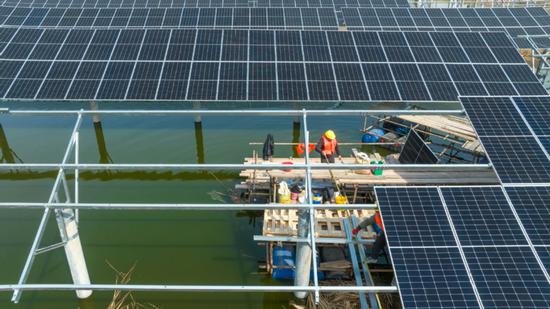Opening-up of energy sector to expand further

Employees install solar panels at a village in Tangshan, Hebei province. (ZHANG YONGXIN/FOR CHINA DAILY)
China will further expand its opening-up in the energy sector, engage in extensive international cooperation and contribute to a more stable global energy supply, said Zhang Jianhua, head of the National Energy Administration, on Wednesday.
Zhang said China has made significant contributions to stabilize the global energy market and its green transformation by providing affordable electricity worldwide. Over the past decade, average power costs per kilowatt-hour of wind and solar power projects have fallen by over 60 percent and 80 percent, respectively.
Globally, the country has to date contributed over 80 percent of photovoltaic modules and 70 percent of wind power equipment. Its products have been exported to over 200 countries and regions, Zhang said.
"Building a diversified, clean and stable energy supply system is an important path for developing countries to enhance their energy security capabilities. We are willing to work with other countries around the world to develop more ambitious green energy development plans based on each country's endowments and development needs."
Zhang's remarks were made during the Third Belt and Road Energy Ministerial Conference held in Qingdao, Shandong province.
During the conference, Zhang said the NEA is promoting the expansion of the Belt and Road Energy Partnership, which is joined by 34 countries, with Iran being a new partner this year.
The NEA also released the Belt and Road Green Energy Cooperation Action Plan at the conference, calling for participating countries to collectively enhance their capabilities for green energy security, strengthen green energy policy and institutional innovation, collaborate on green energy technological innovation and build a strong Belt and Road Energy Partnership.
Hu Ming, head of the China Electric Power Planning and Engineering Institute (EPPEI), said that developing countries' combined installed capacity of power generating units will exceed 10 billion kilowatts by 2030, indicating huge demand for power infrastructure.
"Renewable energy will become the primary source of electricity generation in developing countries, accounting for over 70 percent by 2030 and over 80 percent by 2040. Prospects for the photovoltaic power market are broad, and offshore wind power is expected to become a new growth point," Hu said.
According to a blue book released at the conference by the EPPEI, over the past five years, power consumption in developing countries has been steadily increasing at an annual rate of about 4.4 percent. By 2023, it reached 17.7 trillion kilowatt-hours, representing 65.2 percent of the global total.
Over the same period, the installed capacity of power generating units in developing countries has grown at an annual rate exceeding 6 percent, reaching 5.65 billion kilowatts in 2023, which accounts for 63.2 percent of the global total, the blue book said.
Last year, the installed capacity of renewable power generating units in developing countries reached 2.6 billion kW, up nearly 20 percent year-on-year. Solar and wind capacities increased to 1 billion kW and 589 million kW, respectively. These countries have significantly expanded their power transmission and distribution networks, achieving 90.3 percent grid coverage, it said.
The energy storage industry in developing countries is rapidly developing, with newly added installed capacity reaching 53.5 million kWh in 2023, a 324.6 percent increase from the previous year.

